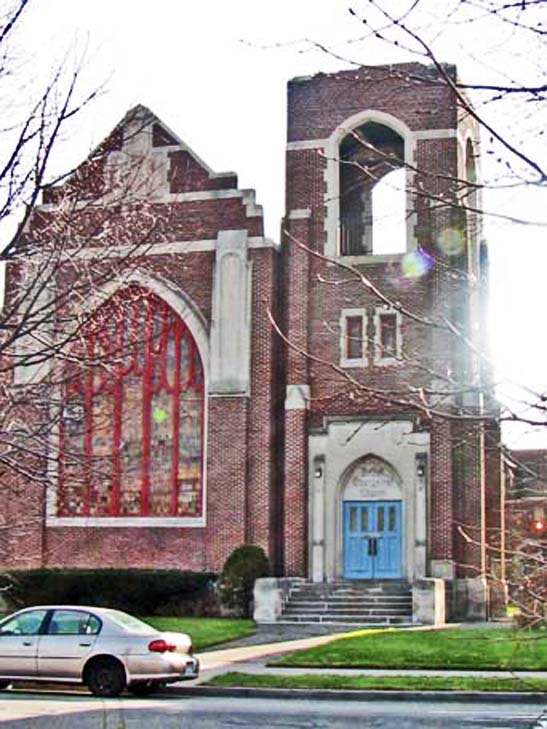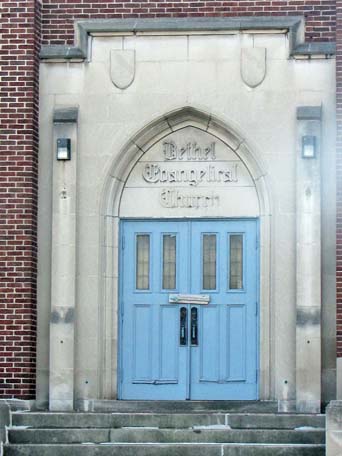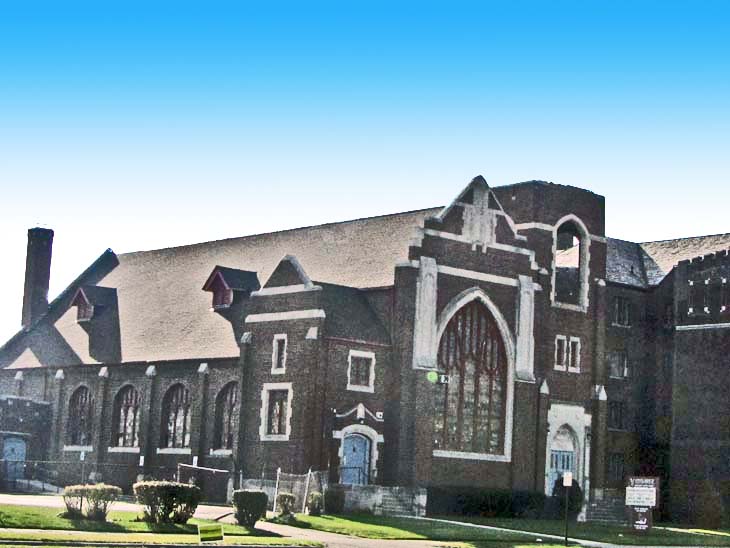

This church has historical significance because Reinhold Niebuhr served as pastor when the congregation built this Gothic structure. In most every era, there are clergymen who become prominent for their teachings or for the large audience they reach. However, their styles change and their appeals are based upon a variety of issues. Without doubt, Father Charles Coughlin was the most prominent clergymen to come from Detroit. However, in the post-World War II era, Reinhold Niebuhr writings were widely read, even though his audience was not all similar to the one that Father Coughlin reached about 15 years earlier.

Niebuhr was born in rural Missouri in 1892. His father—an immigrant—was a German Evangelical minister in the Calvinist tradition. Niebuhr earned an undergraduate degree at Elmhurst College in 1910 and then studied at Eden Seminary in St. Louis. Later he earned a Bachelor of Divinity degree from Yale in 1914 and Master of Arts degree the following year. He also accepted his first pastoral appointment in 1915— leader of a 65 person German language Bethel Evangelical Church in Detroit.
Almost as soon as he got to Detroit, he began writing essays for various publications. Originally, he was a pacifist but wrote extensively about the need for German-Americans to support their new country during World War I. He also championed relief efforts while building his congregation in Detroit.
By the 1920s, he began preaching a Social Gospel. He was very seriously disturbed by the dehumanizing consequences of the Fordist system of production. He was certainly not alone in suggesting that modern system of industrial production epitomized by Ford’s plants meant that workers were no more than mindless appendages of machines. This system, its critics argued, would ultimately dehumanize workers with serious consequences for society.
One of his most famous quotes from this period appeared in the book he wrote about his experiences in Detroit:
"We went through one of the big automobile factories to-day. . . . The foundry interested me particularly. The heat was terrific. The men seemed weary. Here manual labor is drudgery and toil is slavery. The men cannot possibly find any satisfaction in their work. They simply work to make a living. Their sweat and their dull pain are part of the price paid for the fine cars we all run. And most of us run the cars without knowing what price is being paid for them. . . . We are all responsible. We all want the things which the factory produces and none of us is sensitive enough to care how much in human values the efficiency of the modern factory costs."
In 1928, Niebuhr had something of a national reputation because of his extensive writings. He left Detroit to be a professor of Theology at Union Theological Seminary in New York, an appointment he held until his death in 1960. During the Depression decade, Niebuhr strongly advocated Socialism and Pacifism, but by the time of World War II, he backed away from those ideas. Indeed, he eventually endorsed the nation’s participation in World War II Today we have television preachers and clergymen who frequently condemn what they see as grievous moral evils: abortion, homosexuality and same-sex marriage. There are, however, no religious leaders who reach a moderately large audience by raising fundamental questions about whether the nation’s economic system and its foreign policies are congruent with Abrahamic traditions. Niebuhr did so quite effectively. It is not that he was an extremely popular author, but he lived and taught in New York City where he reached a large audience. His two best known books, I believe, are Moral Man and Immoral Society (1933) and the Nature and Destiny of Man (1941). Most people completing a bachelor’s degree in the humanities in the post-World War II would become at least somewhat familiar with the moral teachings and writings of Niebuhr. In his era, Niebuhr commented upon all of the major issues affecting the nation and took a .liberal stance on almost all of them. His interpretation of Christian ethnics and the nature of mankind led him to eventually criticize Communism, secular humanism and much of the emerging liberal Christian theology. His work was significant enough that editorial writers and the more erudite political co mmentators few commented frequently and extensively about what Niebuhr wrote. The second President Bush averred that Detroit’s Reinhold Niebuhr was his favorite theologian. President Obama also commented that he had been more influenced by the writing of Niebuhr than those of any other theologian.
mmentators few commented frequently and extensively about what Niebuhr wrote. The second President Bush averred that Detroit’s Reinhold Niebuhr was his favorite theologian. President Obama also commented that he had been more influenced by the writing of Niebuhr than those of any other theologian.
In 2005, the New York Times published a long article asking why Reinhold Niebuhr was forgotten in this new century. The writer—Author Schlesinger—described the great importance of Niebuhr as an intellectual and moral leader in the Twentieth Century who addressed numerous questions about ethnics and the nature of society. Schlesinger observed that religious and moral issues seemed to be especially important in the political discourse of the new century. But few of the politicians who frequently invoked Biblical and religious principles for their decisions seldom, if ever, referred to the ideas of the once influential Niebuhr.
Niebuhr suggested that many of the men in his Detroit congregation were blue-collar workers in the auto industry. Their exploitation, as he understood it, may have helped motivate him to call for Socialism to replace capitalism and motivated him to preach a Social Gospel. His critics ask how much he really knew about assembly line work. They suggest that his Detroit congregants were likely skilled craftsmen. This seems quite plausible in light of the attractive church pictured above. When Reverend Niebuhr arrived in Detroit, his congregation was very small in size. When he left in 1928, there were at least 700 congregants. The Gothic church that you see is quite large and located on what was then a valuable property on West Grand Boulevard.
Within this church is a 1928 memorial mosaic given by the Matthai family in honor of Louise Edna Matthai designed by Gwen Lux who went on to become a well known sculptor and executed in Pewabic Tiles. It shows Jesus visiting Simon the Leper in Bethany at the home of Mary, Martha and Lazarus.
I do not know what happened to this congregation after World War II when many Detroit residents moved to the suburbs. I do not believe the congregation moved to another location. Apparently the church was sold to the Mayflower Missionary Baptist congregation.
Architects: Mildner and Eisen
Date of Completion: 1921
Architectural Style: Modern Gothic
Reinhold Niebuhr’s book about his life in Detroit: Leaves from a Notebook of a Tamed Cynic
(Chicago: Wellett, Clark and Colby, 1929; subsequently republished)
City of Detroit Designated Historic District: Not listed
State of Michigan Registry of Historic Sites: Not listed
National Register of Historic Places: Not listed
Photograph: Ren Farley; November 20, 2010
Description prepared: May, 2011
